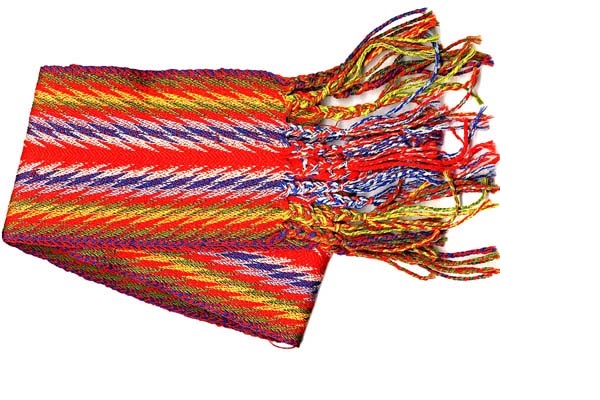Ceinture fléchée, 1885, Artiste inconnu, Musée communautaire de Windsor (Windsor), 1961.229.
Courtoisie du Musée communautaire de Windsor, Cadeau de David J. Cameron

Ceinture fléchée, 1885, Artiste inconnu, Musée communautaire de Windsor (Windsor), 1961.229.
Courtoisie du Musée communautaire de Windsor, Cadeau de David J. Cameron
Arrowhead Sash, 1885, Artist Unknown, Windsor’s Community Museum (Windsor), 1961.229.
Courtesy of Windsor’s Community Museum, Gift of David J. Cameron


D’une largeur qui peut varier entre 15 et 25 centimètres et d’une longueur qui peut facilement atteindre 2 mètres, la ceinture fléchée est d’abord un élément des costumes traditionnels canadien-français et métis, historiquement associé à la traite des fourrures. On en fait mention dans les livres de la Compagnie de la Baie d’Hudson dès 1798. Elle sert à entourer le capot des hommes (manteau fabriqué avec de la laine et du lin, communément appelé « étoffe du pays ») pour conserver la chaleur corporelle et aussi pour soutenir leurs dos lors du transport de lourds ballots de pelleteries. Les ceintures aidaient aussi à prévenir des hernies chez ces voyageurs-canoteurs.
Le tissage en forme de V ou de W, aux couleurs vives, s’impose généralement à partir de 1850. Le travail long et exigeant pour confectionner ces ceintures les rende très coûteuses, jusqu’à ce que la fabrication mécanique s’impose. À la fin du XIXe siècle, les bourgeois des villes en récupèrent l’usage et la mettent au profit d’un sport populaire, la raquette. Aujourd’hui, des danseurs de groupes folkloriques et des violonistes de musique traditionnelle arborent fièrement la ceinture fléchée. Elle entoure aussi le Bonhomme du Carnaval de Québec et le Voyageur officiel du Festival du voyageur de Saint-Boniface.
Lorsque Elizabeth Simcoe, épouse du lieutenant-gouverneur de l’Ontario John Grave Simcoe, séjourne à Québec en 1791-1792, elle rapporte que chez les Canadiens « their coats are tied with a coloured sash ». Après avoir accompagné son mari au bal chez le gouverneur Haldemand, au Château Saint-Louis, elle écrit : « the Canadian coats with Capots and sashes look very picturesque ».
À Monetville, près du lac Nipissing, il y a une pourvoirie appelée Saenchiur Flechey, qui signifie « ceinture fléchée » dans la langue michif (déformation du mot « métis »)
The arrowhead sash, ranging in width from 15 to 25 centimetres and easily reaching a length of two metres, is primarily a piece of traditional French-Canadian and Métis clothing historically associated with the fur trade. Reference to the sash can be found in the books of the Hudson’s Bay Company as early as 1798. It was worn around men’s capotes (overcoats made of homespun wool and linen, commonly called “étoffe du pays”) to retain body heat and to support their backs when they carried heavy bundles of pelts. The sashes also helped to prevent hernias among these voyageurs and canoe men.
The brightly coloured V- or W-pattern of the weave generally began to emerge in 1850. The time-consuming, demanding work of crafting these sashes made them very expensive, until mechanical production methods were developed. In the late 19th century, the city-dwelling bourgeois reclaimed the sash for use in a popular sport, snowshoeing. Folk dancers and fiddlers who play traditional music now proudly wear the arrowhead sash. It also adorns Bonhomme, the mascot of the Québec Winter Carnival, and the Official Voyageur of the St. Boniface Festival du voyageur.
While living in Québec City from 1791 to 1792, Elizabeth Simcoe, the wife of Lieutenant-Governor of Ontario John Graves Simcoe, reported of the Canadians that “their coats are tied with a coloured sash.” After accompanying her husband to a ball hosted by Governor Haldimand at Château Saint-Louis, she wrote that “the Canadian coats with Capots and sashes look very picturesque.”
In Monetville, near Lake Nipissing, there is an outfitter called Saenchiur Flechey, which means “ceinture fléchée” (arrowhead sash) in the language known as Michif (derived from the word “Métis”).
Paul François Sylvestre
Source
Abrité dans la maison historique François Baby, ce musée local met l’accent sur l’histoire des Français, des Anglais, des Premières Nations, des Noirs et d’autres groupes culturels de la Ville de Windsor, à partir de 1701 jusqu’à nos jours. Le musée collectionne, conserve et expose des accessoires liés à l’histoire du comté d’Essex. Des visites de groupes scolaires sont offertes dans le cadre d’un programme au musée et à un centre d’interprétation situé à l’extérieur qui appartient à la Fondation du patrimoine ontarien. Les bénévoles se rencontrent tous les mois et collaborent avec le personnel pour offrir des reconstitutions historiques des événements, des visites en autocar et des activités spéciales.
Housed in the historic François Baby House, this community museum focuses on the history of French, British, First Nations, Black and other cultural groups in the City of Windsor and area, from 1701 to the present. The site collects, preserves and displays materials related to the history of Windsor and Essex County. School group tours are offered through a program at the museum and at an off-site Interpretation Centre owned by the Ontario Heritage Foundation. Volunteers meet monthly and work with staff to offer living history events, bus tours and special events.
Info: 254 Pitt St. West, Windsor, ON, N9A 5L5
Tel: 519-253-1812
www.citywindsor.ca